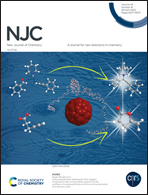Structure–property correlations of the nonlinear optical properties of a few bipodal D–π–A molecules – an experimental and theoretical approach†
Abstract
The nonlinear optical (NLO) properties of a series of pyran based bipodal D–π–A molecules have been studied experimentally and theoretically. The bipodal D–π–A molecules prepared exhibited a very high NLO response depending on the electron donating ability of the donor moiety. In the prepared series, the molecule with dianisylphenylamine (DAPA) as the donor showed the maximum value for the TPA coefficient (β) for a given acceptor unit. The static dipole moment (μtot), mean polarizability (αtot), polarizability anisotropy (Δα), static first order hyperpolarizability (βtot) and second order hyperpolarizability (γtot) were calculated by using DFT at the B3LYP/6-311++G(d,p) level of theory. The trend obtained for the computed hyperpolarizability (βtot) values is in line with the trend in the experimentally obtained values of the TPA coefficient (β) with the variation in the donor capacity.



 Please wait while we load your content...
Please wait while we load your content...